Aukaha: Xoë Hall
Jul 11, 2023

Xoë Hall – artist, dreamer, powerhouse and māmā
Nā Hannah Kerr
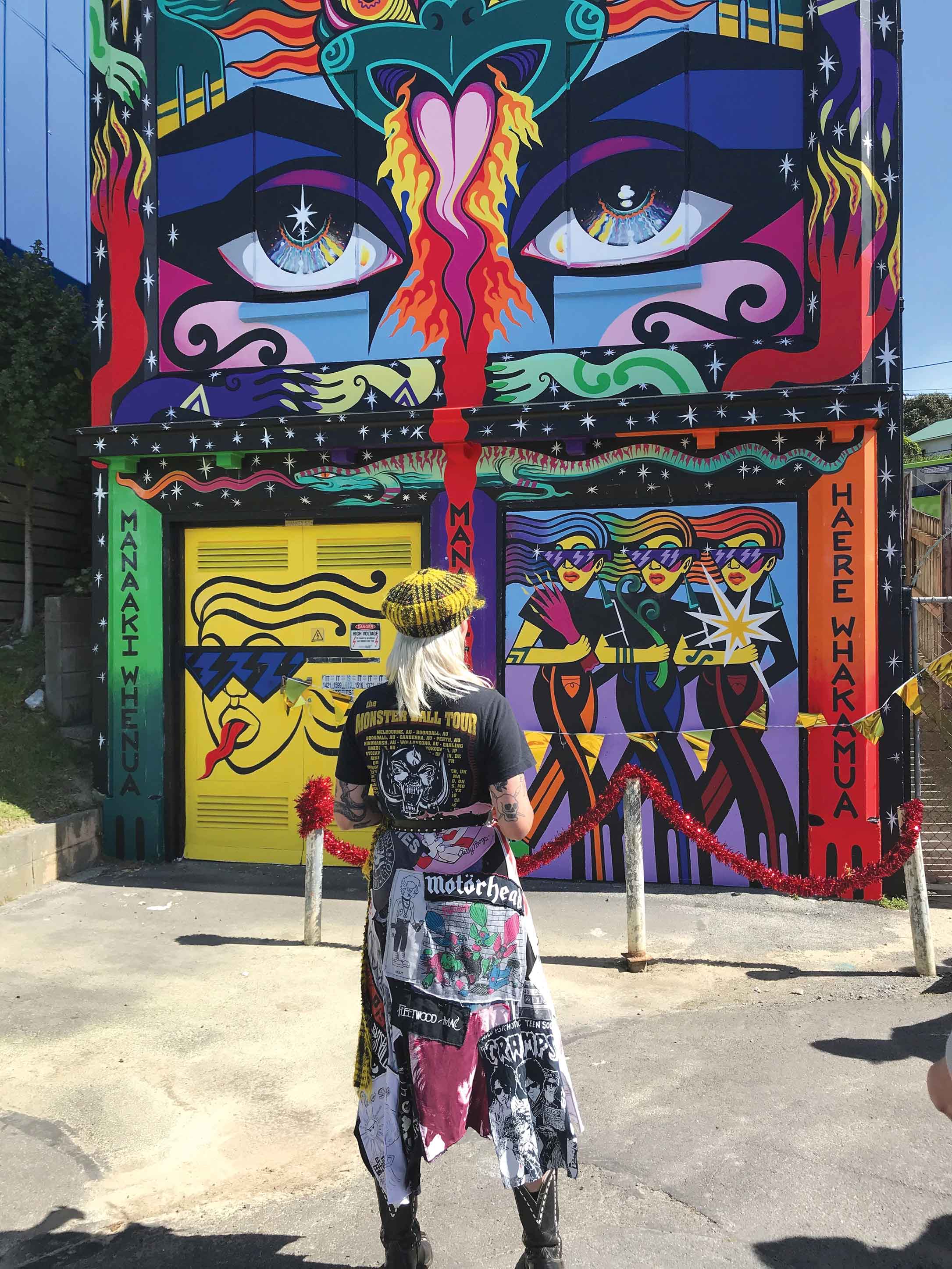
Xoë in front of a mural painted by Dream Girls Art Collective for Toi Rauwhārangi
Walking into Bloodline at the Dunedin Public Art Gallery (DPAG), the Kāi Tahu creation story wraps itself around you. It feels as if you are being transported into a dream world where the stories of our tīpuna live and breathe.
Kāi Tahu artist Xoë Hall has radically transformed the white gallery walls and created a beautiful, vibrant retelling of our creation story. Stunning, large-scale and brightly coloured murals of atua are floor to ceiling, as well as nods to Hine-nui-te-pō, Mahuika and Māui. Pounamu adorns the walls throughout.
Bloodline acknowledges Takaroa as the first husband of Papatūānuku. While Takaroa spent much of his time in the great expanse of the ocean, he would eventually return to find Papa intertwined with the Sky Father, Rakinui (nephew of Takaroa). Despite his efforts, their love was untouchable, and Takaroa had no choice but to let it be and stepped aside. “My dad brought us up on stories of our tīpuna Mōtoitoi; they fascinated and inspired me as a child and still do today. We were lucky dad was grounded in his whakapapa and made sure we knew where we came from,” says Xoë.
Growing up in Porirua with her mum, dad and two younger sisters, it was important to remain connected to the homes of their tīpuna through stories. Xoë’s whakapapa is to Puketeraki Marae, with Kāi te Ruahikihiki and Kāti Huirapa as her hapū; its a long way from the North Island town where she was raised.
“He [dad] would take us to all gatherings and reunions, with a grand tour of the places where the stories he told us originated from.” Even when very young she could feel the magic of these places.
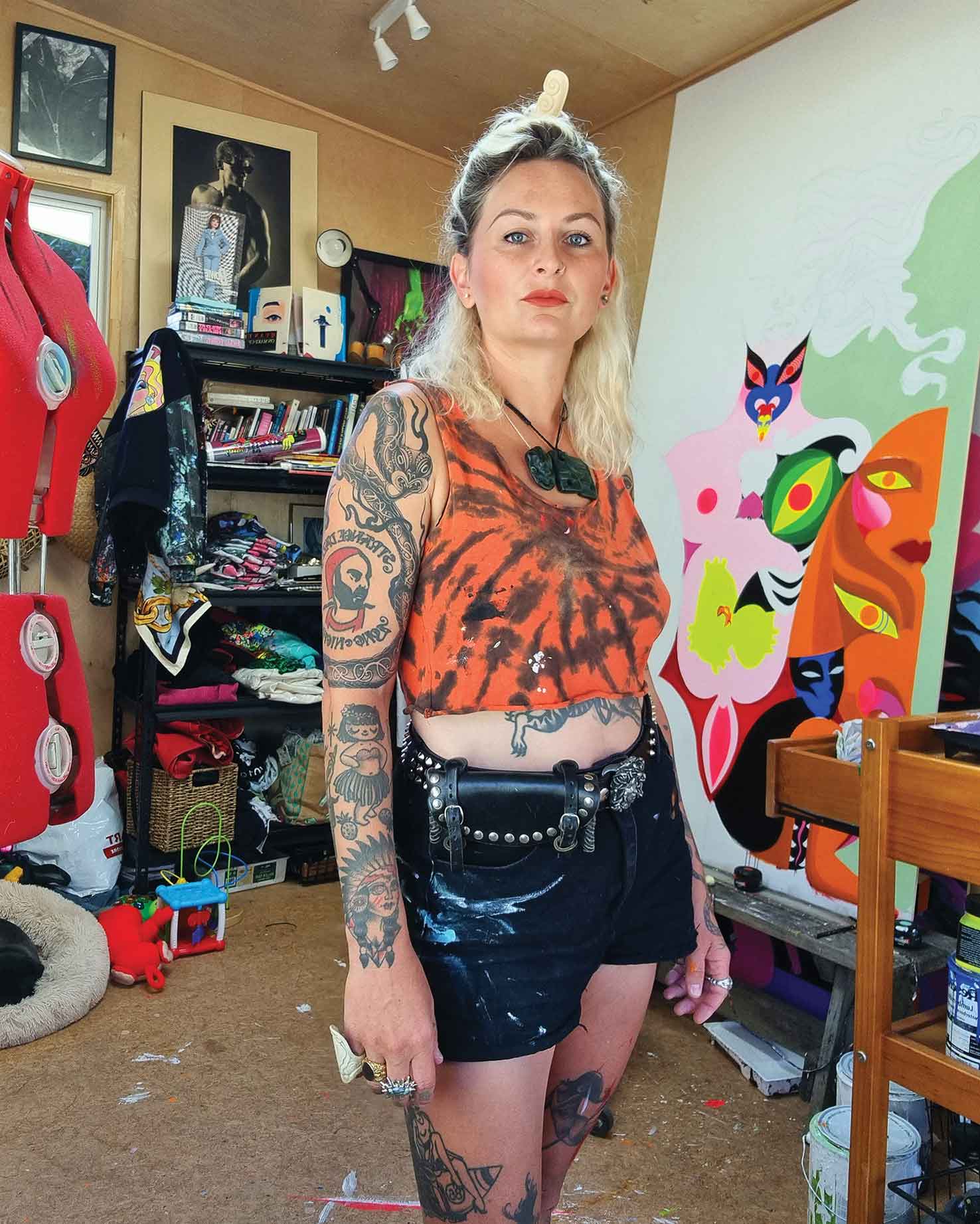
Xoë in the studio
Sadly, at the age of 14, Xoë lost her beloved father and her connection to the stories of her tīpuna. As disorientating as it was, she continued her quest for knowledge and understanding of her whakapapa. “Being Kāi Tahu was the first gateway into my imagination and as I continue to grow and have my own family, it is what grounds me in this crazy world.”
Xoë’s large-scale murals can be found throughout Aotearoa, in public art galleries and adorning city street walls. Kuīni of the Worlds sits emblazoned on a bunker outside Christchurch City Gallery and tells the story of Hinetītama, the flashing red dawn, who becomes Hine-nui-te-pō, the night queen and receiver of souls in the afterlife.
Xoë says street art is the only canvas big enough for her to express herself and it’s the reason she accidentally fell into her career. “I remember my primary school giving me a wall to paint way back when I was about 11 or 12, and I also remember drawing on the walls at home. It was a natural progression for me to paint city walls.”
In mid-2022, Xoë became a māmā for the first time. Wiremu’s birth story is harrowing to say the least and Xoë issues a warning before sharing. “When your body literally becomes a portal between two worlds it’s going to be painful and life altering! I almost didn’t make it. After my emergency C-section, due to a hidden tear in my uterus, it took five hours before they could stop the bleeding.
I lost seven litres of blood and woke up in ICU unable to hold my pēpi for a few days or walk for over a week.” Baby Wiremu was perfectly fine and healthy. “We are so lucky! I have been surprisingly better than ever, mentally, since the experience for many reasons … but there’s nothing like a brush with Hine-nui-te-pō to make you appreciate being alive.”
With many projects on the go, Xoë started bringing Wiremu along to her mural sites from the very beginning. Her partner and friends also accompany her, so the pair are well-looked after. However, having Wiremu has changed her approach to work. Learning to juggle both worlds can be difficult and Wiremu comes first, of course. But just one hour at the studio walls is better than nothing.
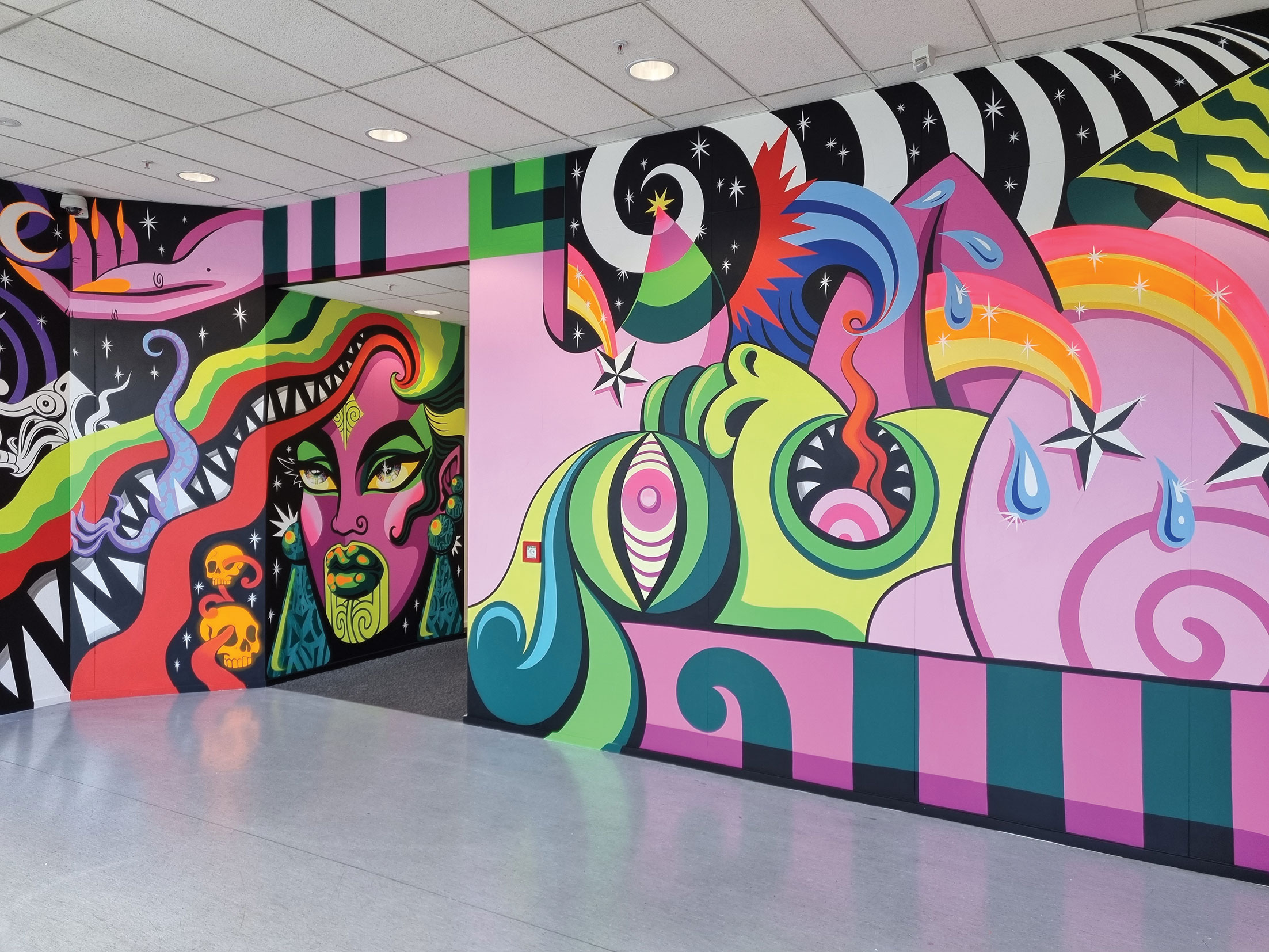
‘Bloodline’ in Dunedin Public Art Gallery
When asked how she feels after becoming a māmā, Xoë at first struggles to find the words, but then eloquently responds in a way that makes you dream about the special connection mothers must have with their first pēpi: “I feel like a veil has been lifted and I am more curious than ever, more amazed and intrigued than ever about life, the past and the future.”
Wiremu has had the stories of his tīpuna told to him since before he was earth-side. He was in Xoë’s belly when she painted Bloodline on the walls of DPAG, and she will endeavour to do what her dad did for her and her siblings. “I took him to the places that we whakapapa to and I will tell him all the stories, show him all the places and give him the knowledge he needs to know who he is in this world.
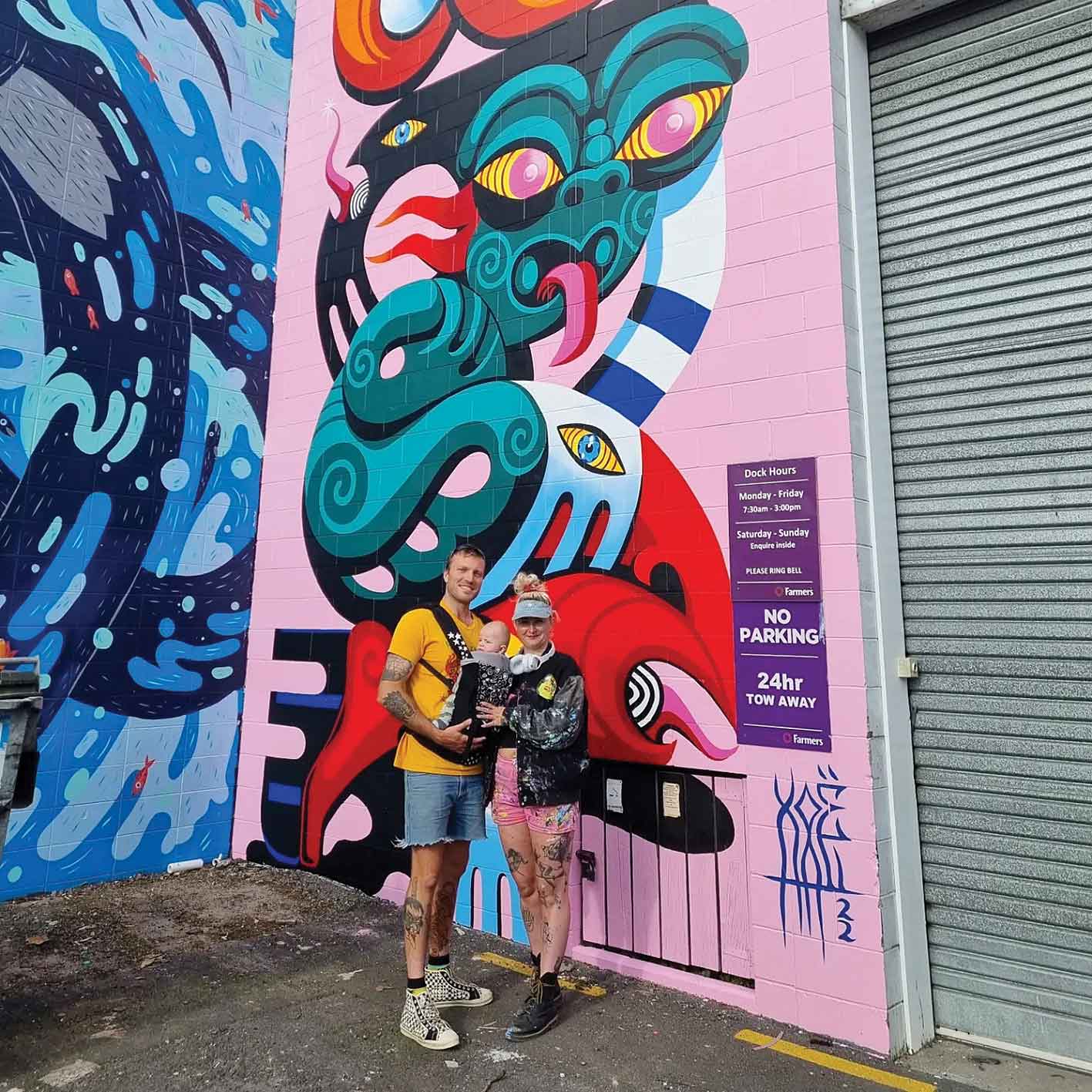
Xoë with her partner and pepi Wiremu, in front of ‘Raw Power’ the first mural she painted after becoming a māmā
“I buzz out every day when I look at Wiremu … he is a physical amalgamation of all his ancestors, from my side and his dad’s. Wiremu is ancient, but brand new. Timeless. It’s really crazy to think about.”
Xoë’s work is inspired by the pūrākau she is beginning to pass down to Wiremu alongside atua, wāhine, music, films and the ‘80s aesthetic. Wāhine are constant throughout her work, from Papatūānuku, Hineraumati, to Mahuika. They are depicted as badass beings, with fiery manicures, sunglasses, beautiful moko kauae and perfect pouts. It’s the women’s constant fight for freedom and equality around the globe and throughout multiple eras that constantly inspires Xoë.
“Never backing down, constantly fighting the shackles on their voices and bodies. Here in Aotearoa, I am especially enjoying the power in the revival of te reo and moko kauae. It says colonisation hasn’t won.”
It’s with these powerful inspirations and the original spark of creativity from her dad’s storytelling that help form her impressive and large-scale works. While her art is a stunning example of our myths being retold in modern style, she also loves the perseverance and strength of traditional Māori art practices. “Cutting, tattooing, painting, carving, building through generations of whitewash and colonisation. They are a visual, physical and a real world pillar of strength and a reminder of who we are. A home for those like me who are moving into a modern contemporary era of Māori art.”
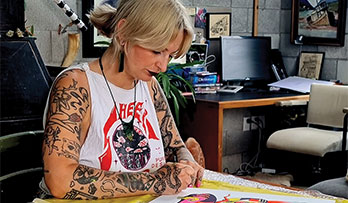
While working a lot on her own mahi, Xoë is also a part of the Dream Girls Art Collective, alongside fellow artists Gina Kiel and Miriama Grace Smith (Ngāti Hau, Ngāti Maniapoto, Te Arawa, Ngāti Toa). Their joint creations are popping up everywhere, with the team designing a stage for Wellington street festival CubaDupa, brightening up construction site walls in our cities, and recently painting a mural at Tauranga Art Gallery for the group show, Work Out.“We worked with an absolute dream team at the gallery; it was amazing to have extra hands and minds helping with the process of bringing our murals off the walls, like the flaming staircase. POP-POCOLYPSE was intended to be an epic story of jumping onboard the waka or riding a badass taniwha into a better future.” The group has a few things in the pipeline and Xoë says in the near future she will have an exhibition in a gallery of mural- size paintings on canvas.
For all the rakatahi Māori who wish to tell our stories like Xoë, she has some special advice: “Trust your gut, be brave. Try to tell your story because it is unique and no-one else can tell it like you.”
Xoë currently has mural exhibitions at Dunedin Public Art Gallery and Christchurch City Gallery as well as murals on buildings in Te Whanganui-a-Tara, Porirua, Taupō and Tāmaki Makaurau.
You can follow Xoë on her website www.xoehall.com or Instagram handles @hallofxoe and @official.dreamgirlsart for exciting announcements over the coming months
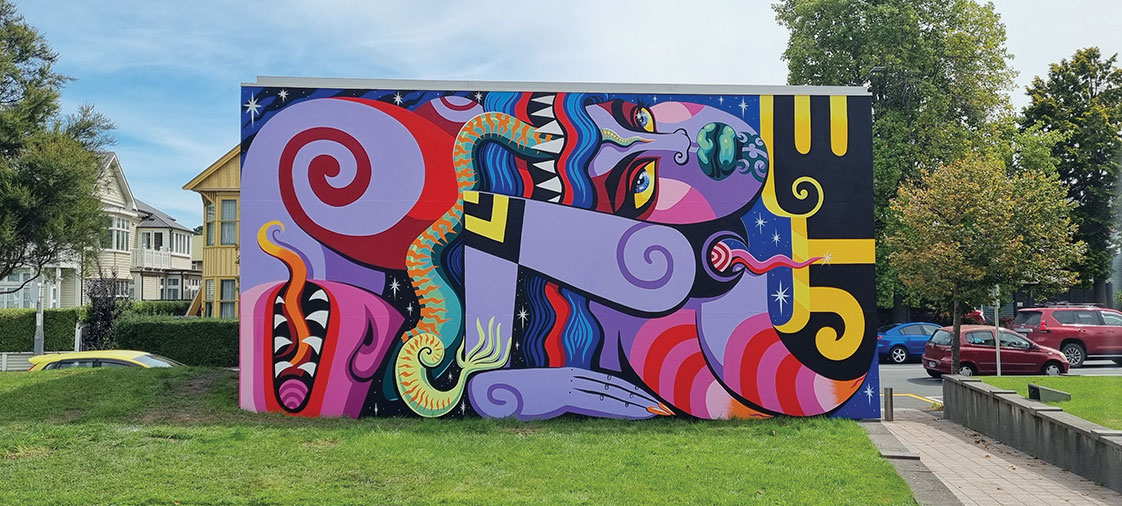
Kuīni of the worlds’ on a bunker outside Christchurch Art Gallery Te Puna o Waiwetū.